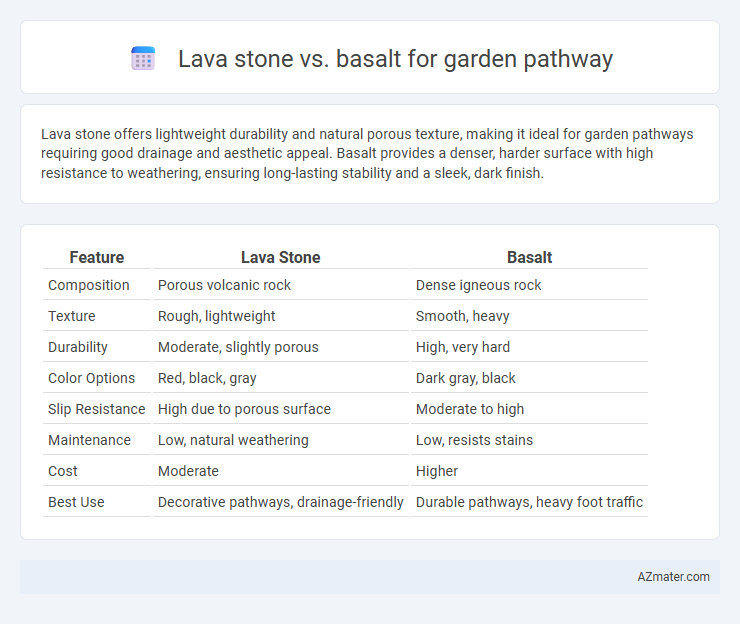Lava stone offers lightweight durability and natural porous texture, making it ideal for garden pathways requiring good drainage and aesthetic appeal. Basalt provides a denser, harder surface with high resistance to weathering, ensuring long-lasting stability and a sleek, dark finish.
Table of Comparison
| Feature | Lava Stone | Basalt |
|---|---|---|
| Composition | Porous volcanic rock | Dense igneous rock |
| Texture | Rough, lightweight | Smooth, heavy |
| Durability | Moderate, slightly porous | High, very hard |
| Color Options | Red, black, gray | Dark gray, black |
| Slip Resistance | High due to porous surface | Moderate to high |
| Maintenance | Low, natural weathering | Low, resists stains |
| Cost | Moderate | Higher |
| Best Use | Decorative pathways, drainage-friendly | Durable pathways, heavy foot traffic |
Introduction: Choosing Materials for Garden Pathways
Lava stone and basalt are both durable volcanic rocks commonly used for garden pathways due to their strength and natural aesthetics. Lava stone features a porous texture that provides excellent traction and water drainage, making it ideal for slippery or wet conditions. Basalt offers a denser, smoother surface with deep black or dark gray tones, enhancing pathway durability and complementing modern garden designs.
What is Lava Stone?
Lava stone, a porous volcanic rock formed from cooled molten lava, is prized for its lightweight texture and natural rugged appearance, making it ideal for garden pathways. It offers excellent drainage and durability while maintaining a warm, earthy color palette compared to basalt's denser, darker composition. Garden pathways using lava stone provide superior slip resistance and a unique aesthetic that complements natural landscapes.
What is Basalt?
Basalt is a dense, fine-grained volcanic rock commonly used in garden pathways due to its durability and natural dark color that contrasts well with greenery. Unlike lava stone, basalt offers a smoother texture and higher resistance to weathering, making it ideal for areas with heavy foot traffic. Its composition of magnesium and iron-rich minerals ensures long-lasting strength and minimal maintenance in outdoor landscaping applications.
Visual Appeal: Lava Stone vs Basalt
Lava stone offers a rich, porous texture with a range of deep reds, blacks, and browns that create a striking, natural look for garden pathways. Basalt provides a smoother, more uniform surface in dark gray to black tones, lending a sleek and modern aesthetic to garden designs. The choice between lava stone and basalt significantly influences the visual appeal by balancing rustic charm against contemporary elegance.
Durability and Longevity Comparison
Lava stone offers high durability with excellent resistance to weathering and erosion, making it ideal for garden pathways exposed to varying climates. Basalt, known for its dense and hard composition, provides superior longevity and withstands heavy foot traffic without significant wear. Both materials ensure long-lasting garden paths, but basalt typically offers greater durability over extended periods due to its higher compressive strength.
Slip Resistance and Safety Considerations
Lava stone offers excellent slip resistance for garden pathways due to its porous texture, which provides natural grip even when wet. Basalt, while denser and less porous, can become slippery when polished or covered with moss, requiring additional anti-slip treatments for safety. Choosing lava stone enhances safety on pathways exposed to moisture, making it a preferred option for preventing slips and falls.
Maintenance Needs: Lava Stone vs Basalt
Lava stone requires minimal maintenance due to its porous nature, which allows for excellent drainage and reduces water pooling, making it resistant to algae and moss growth. Basalt, being denser and less porous, may retain moisture longer, increasing the likelihood of moss buildup and requiring more frequent cleaning to prevent slipping hazards. Both stones benefit from occasional sweeping and pressure washing, but lava stone's natural texture helps maintain its appearance with less effort over time.
Environmental Impact of Each Material
Lava stone and basalt differ in environmental impact due to their extraction and durability. Lava stone, formed from cooled volcanic lava, is porous and lightweight, making it easier to source with less environmental disruption, while basalt, a dense igneous rock, requires more intensive quarrying that can affect local ecosystems. Both materials are durable and long-lasting, reducing the need for frequent replacement, but lava stone's natural heat absorption and retention properties contribute to microclimate regulation in garden pathways.
Cost Comparison for Garden Pathways
Lava stone typically costs between $1 to $3 per square foot, making it a budget-friendly option for garden pathways, while basalt ranges from $3 to $7 per square foot due to its higher density and durability. Installation expenses for both materials are similar, averaging $5 to $10 per square foot, but basalt's increased longevity can reduce long-term maintenance costs. Choosing lava stone offers initial savings, whereas basalt provides a cost-effective investment over time due to its resistance to weathering and wear.
Which is Best for Your Garden Pathway?
Lava stone and basalt are both durable volcanic rocks ideal for garden pathways, but basalt's denser composition offers superior strength and longevity, making it best for high-traffic areas. Lava stone is lighter and more porous, providing excellent drainage and a unique textured appearance suited for decorative pathways. Choosing between them depends on whether you prioritize durability with basalt or aesthetic variety and drainage with lava stone for your garden pathway.

Infographic: Lava stone vs Basalt for Garden pathway
 azmater.com
azmater.com